Rigby cardmodel WWII tank
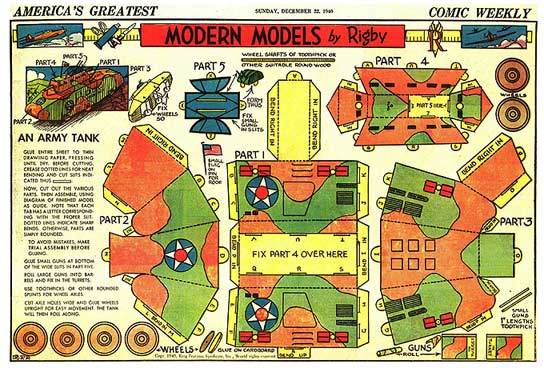 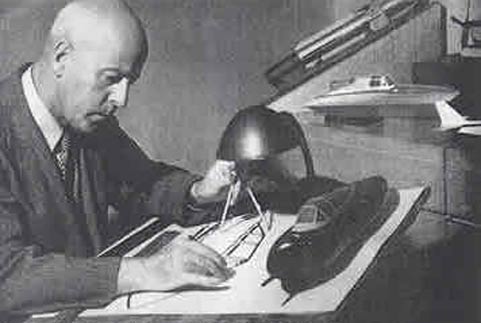 Wallis Rigby posing at his drawing board. He was quite famous for his many lines of paper models, from ships and trains to actual rubber-powered flying models having been written up in many publications from the 1930s through the 1950s. The boat in the background is made of artist's Bristol board, and houses a real little jet (Jetex) engine. - Publisher's Weekly, 4 Aug. 1951 HISTORY OF RIGBY PAPER AIRPLANES It was during WWII that materials were in short for toys. The materials that were available had restricted use. These restrictions ruled out metal toys, thus all that was available was paper and wood. This led to airplanes as well as other toys that were normally made from metals to be prepared with paper or wood. There was also a shortage of ink that lead to bizarre-colored paper models. Rigby’s products got so popular that it even led to newsreel coverage showing the steps used to design, build, and fly one of these paper model airplanes. They range from simple folded-paper darts to complex 3-dimensional models. These airplanes gave thousands of kids and adults their first try at making models. After WWII however things returned to normal, and paper models rapidly disappeared. Only a few publishers continued to print paper models afterwards. |
Making Cut-out Models for Jetex Power by Wallis Rigby
Abridged from an article in Publisher's Weekly, 4 August 1951
Wallis Rigby, famous paper model designer, tells of his rise to his position of pre-eminence and discusses how he came to use Jetex engines as a source of motive power.
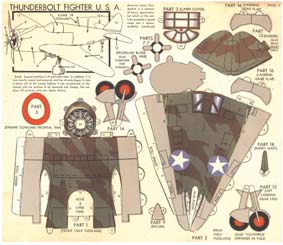 'As a boy, I was flying model gliders when the Wrights were making their first historic flights. After a period of service as the youngest sergeant in the British Army in World War I, I became known in London's Fleet Street as an all-round advertising man, purveyor of slogans, designer of posters and showcards and electric signs, and sold printing for a while. Then I had to free-lance. One day I tried to show an editor a model of the plane in which Amy Johnson had flown to Australia for a world's record. He wouldn't see me. He sent down his little Cockney office boy instead so I flew my model for the boy (after all, he was my future public) and he went up babbling to his editor. The editor sent for me in a hurry and finally ordered a half million reproductions from me!'
'As a boy, I was flying model gliders when the Wrights were making their first historic flights. After a period of service as the youngest sergeant in the British Army in World War I, I became known in London's Fleet Street as an all-round advertising man, purveyor of slogans, designer of posters and showcards and electric signs, and sold printing for a while. Then I had to free-lance. One day I tried to show an editor a model of the plane in which Amy Johnson had flown to Australia for a world's record. He wouldn't see me. He sent down his little Cockney office boy instead so I flew my model for the boy (after all, he was my future public) and he went up babbling to his editor. The editor sent for me in a hurry and finally ordered a half million reproductions from me!'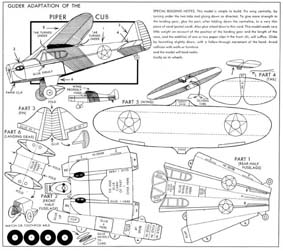
Thus I was launched, and thereafter – up to 1935 – I designed single models for five-and-ten sales or for give-away premium use by Amalgamated Press and other publishers of "boys' papers." Then the Daily Mail ordered and used my first Giant Model Book as part of its premium promotion and the Mail and Daily Express used successive model books. In 1937 Whitman reprinted one of the Rigby books, and in 1939 the New York Daily Mirror used a special edition. The Mirror book resulted in a year's contract with King Features, under which a weekly model, "Modern Models by Rigby," appeared in the Comic Weekly. This was not too great a success, as one could not honestly expect kids to glue down newsprint onto suitable building paper.
It was during World War II that Garden City and McKay accounted for the bulk of the million and a half copies or more of my model books that have been sold. Titles included the McKay "Book of Models" (15 models at $1) and "Book of Scale Models and Working Models"; and the 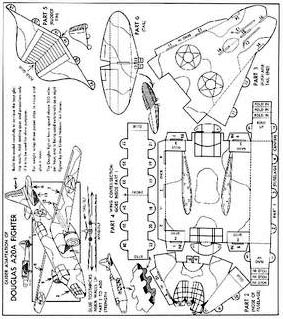 Garden City "Easy to Build Models of War Planes of the World" (16 models including 10 that would fly at $1.39), and "Easy to Build Models of Naval Craft" (24 models at $1).
Garden City "Easy to Build Models of War Planes of the World" (16 models including 10 that would fly at $1.39), and "Easy to Build Models of Naval Craft" (24 models at $1).
After the war, Nabisco issued in Shredded Wheat packages a set of 36 card models of famous airplanes, the total number of cards running into the millions.(see below) At present, "Rigby's Flying Models of Jet and Rocket Planes" (Garden City), "The 7-Foot Model Train Book" (Grosset) and "The Book of Model Fire Engines" (Grosset) sold excellently.
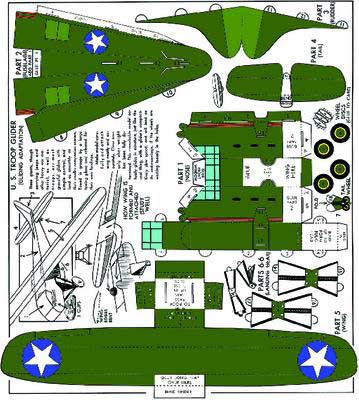 |
Last year (1949!), as an experiment, the rocket book was put on television on a local New York 15-minute Sunday morning program in April over WNBT. Up to that point, this book had been selling reasonably well. What happened? Well, for the first time in the history of these books a vast audience could see what the models would actually "do." Someone had mislaid a film which was to constitute a five-minute portion of the show. Fortunately I had been playing with the set of ten flying rockets with a small boy connected with another act, and I dragged this boy into the show. We ad-libbed, all the planes flew, the boy's spontaneity was excellent, and Garden City got a sale of 5,000 copies at $1 each. But that was a rainy Sunday. The next Sunday was the first fine day of the spring, all our customers were out of doors, and sales dropped, week after week. Later a coast-to-coast Howdy-Doody spot produced sales of 7,343 copies, with the aid of commercial announcements and excellent flying of the models by Claribel the Clown.
I have never used paper or card as a substitute for other materials. For my type of modeling, I have stuck to the use of tough card or paper (paper being always best for power driven model planes) because there is no other material so suitable for the ratio of ruggedness to simplicity in assembling which this class of detailed modeling demands. I have rigorously kept the models in materials and sizes with which the kids can build and, if the models have performance value, with which they can play. Some of the cereal pack models have been excellent, some have been frustrating to young people,. and most have had to be cut from thick, brittle board: this leads to disappointment, a tendency to shy away from this valuable form of fingercraft, and a parental reaction against the medium which has disappointed the child.
A word on accessories, fasteners and sources of power: These, so far, have not been included in my model books (though they have been provided in model kits). Instructions in the books simply tell the assembler to use some easily obtained item such as a round or a flat toothpick for a gun turret, an axle, a mast; paper clips for fasteners, and buffers in the jet plane book; a little glue to strengthen the joints and lengthen the life of the model. Most fastenings are simply a matter of inserting a tab into a slot; and often the tab becomes part of the design. In the fire engine book there is an extension ladder than can be raised and pivoted on a universal joint. Yes, the universal joint is part of the cardboard cut-out, and no other parts are needed at all.
- Air Trails, April 1951
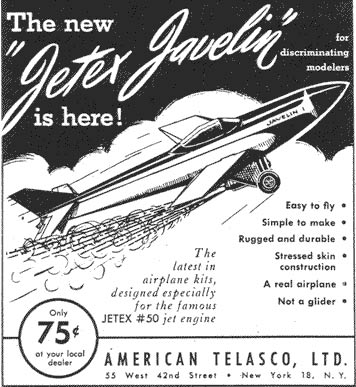 Wallis Rigby's 'Jetex Javelin'. The tail of a completed Javelin can be seen on the right in the photo above, of Rigby in his studio. Note the clever use of the term "stressed skin" to describe Rigby's construction. By folding, bending paper and card, the model's skin is stressed and thus the components gain a strength that give the model its claimed "rugged and durable" characteristics.
Wallis Rigby's 'Jetex Javelin'. The tail of a completed Javelin can be seen on the right in the photo above, of Rigby in his studio. Note the clever use of the term "stressed skin" to describe Rigby's construction. By folding, bending paper and card, the model's skin is stressed and thus the components gain a strength that give the model its claimed "rugged and durable" characteristics.In some models, a long elastic thread or band can serve as a source of power. Airplane models in my books can be launched by hand, or by an elastic catapult, or can be swung overhead in very convincing loops and turns by using a thread fastened to the wings.
In the course of my experiments I have developed my art to a point where, today, I am building and running – almost entirely from good cards – boats and planes which actually run on jet-fuel engines! The furor these card-built jet planes cause when I am running them at a park or some lake has to be seen to be believed. The cry, "It's only cardboard!" is followed by an urgent demand for information as to where to buy them. These models are not in books, but some have been made up in kits, for example the Jetex Javelin Kit, sold by me and the American branch of Telasco, a British firm, which makes the little jet engine. The jet mechanism is entirely safe, by the way. The engines in my jet plane and jet boat models are so constructed that no flame can injure the model or the user.
NABISCO "FLYING CIRCUS" PAPER MODEL COLLECTION
The following card from that series shows the entire series:
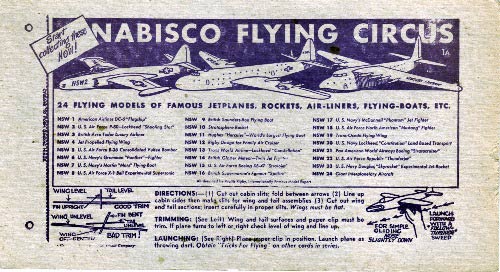 |
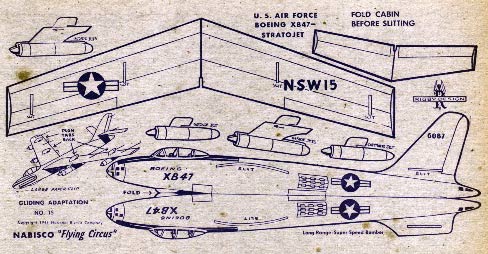 |
| A group of "Flying Circus" models by Nabisco, dated 1948. Nabisco printed a series of flying models on the shredded wheat separator cards. 24 flying models were issued along with numerous information cards on "how to" make, decorate and fly the paper models. | The XB-47 card, 3 15/16" x 7 3/8", shown above, is typical of the style of these cards. The models were designed by Wallis Rigby, a famous British designer of paper and card models. These original separator cards are cheap cardboard, grey in color, but heavy enough to make a creditable model. |
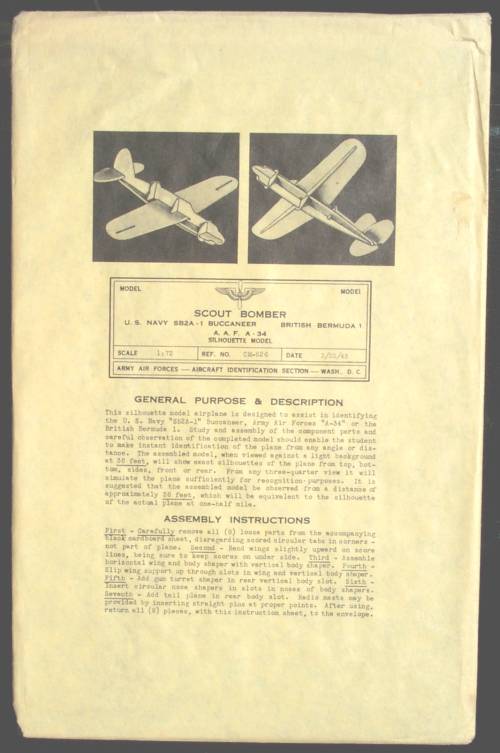 Not a Rigby model but interesting anyway |

